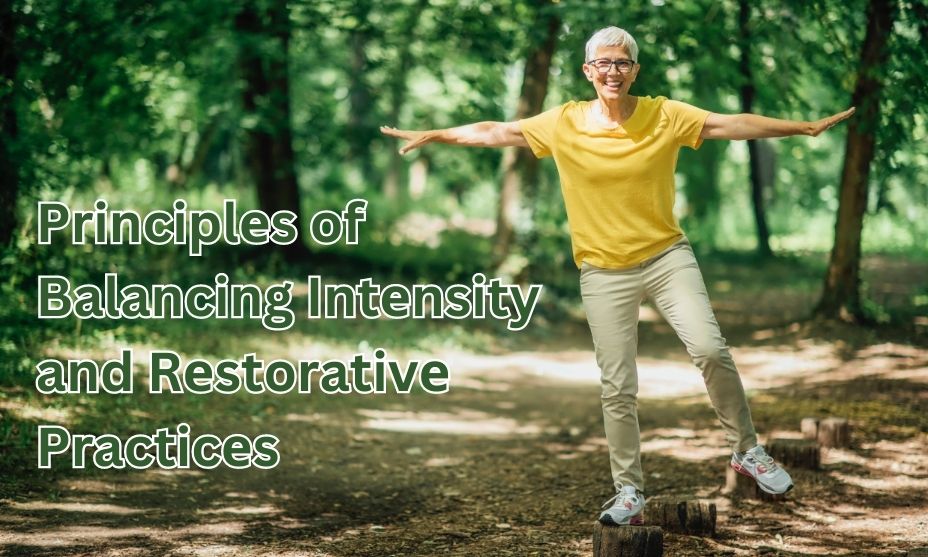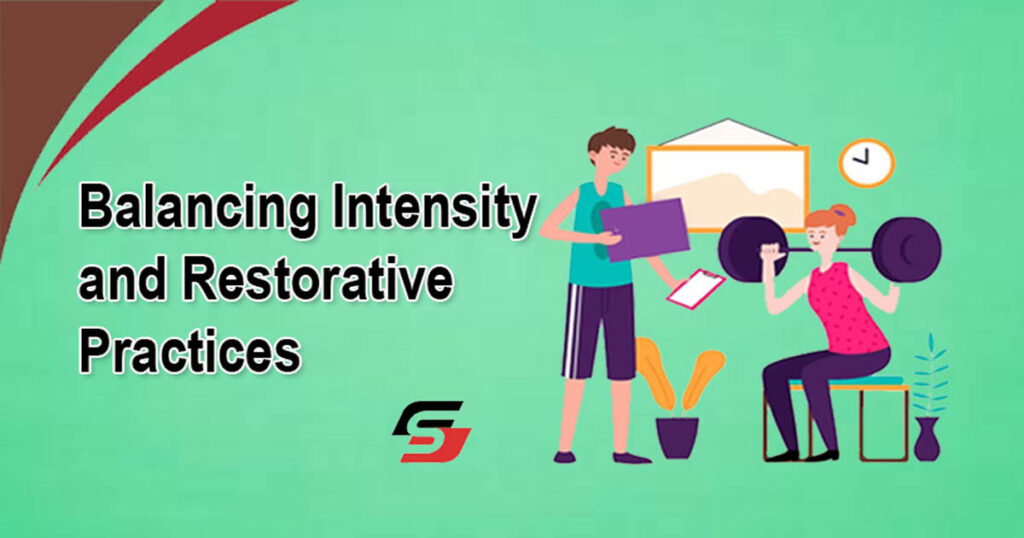Many individuals connect good health and physical fitness with vigorous exercises like jogging, weightlifting, or high-intensity interval training (HIIT). Although these activities can certainly contribute to improved physical and mental well-being, they also have the potential to induce stress, tiredness, and injuries if performed excessively or without sufficient recovery. This underscores the significance of maintaining an equilibrium between high-intensity exercises and activities aimed at restoration, which can promote overall health. Restoration-oriented activities encompass practices that aid in relaxation, recovery, and revitalization of both the body and mind. Such practices include yoga, meditation, massage, and prioritizing sleep. This article will explain the art of balancing exercise intensity with restorative practices to achieve overall well-being.
Benefits of Intense Workouts and Restorative Practices:
Intense Workouts Boost Your Physical and Mental Health
Intense workouts, characterized by high-intensity interval training (HIIT), weightlifting, and cardio sessions, can yield remarkable benefits for your body and mind. Physically, these workouts stimulate muscle growth, enhance cardiovascular fitness, and promote fat loss. The intensity triggers the release of endorphins, often referred to as “feel-good” hormones, which can significantly alleviate stress, anxiety, and depression. Moreover, intense workouts improve metabolic rate, leading to greater calorie burn even during periods of rest. Engaging in such exercises enhances self-esteem and body image, fostering a positive relationship with your physique.
Restorative Practices Enhance Your Recovery and Well-being
Restorative practices, on the other hand, play a vital role in replenishing the body’s resources and facilitating recovery. These practices encompass activities like yoga, meditation, deep breathing exercises, and gentle stretching. By engaging in these practices, you can reduce muscle tension, lower cortisol levels, and promote relaxation. This not only aids in post-workout recovery but also cultivates mental clarity and emotional balance. Restorative practices are an avenue for self-care, enabling you to disconnect from the hustle and bustle of daily life and foster a sense of inner peace.
Balancing Intensity and Restorative Practices Can Improve Your Health Outcomes
The synergy between intense workouts and restorative practices is where the magic truly happens. Balancing the two creates a harmonious cycle that optimizes health outcomes. Intense workouts challenge your body, pushing it to adapt and grow stronger. However, this process also leads to temporary muscle breakdown and fatigue. This is where restorative practices step in, providing the necessary recovery window for your body to heal and rebuild. This balance prevents burnout, reduces the risk of injuries, and sustains long-term commitment to your fitness journey.
Principles of Balancing Intensity and Restorative Practices

Assess Your Optimal Level of Intensity and Frequency of Workouts
Finding the right level of intensity and frequency for your workouts is crucial. It’s essential to listen to your body and gradually increase the intensity as your fitness level improves. Consulting a fitness professional or personal trainer can provide valuable insights tailored to your goals. The frequency of your workouts should be sustainable, allowing for proper recovery between sessions. Striking a balance between challenging yourself and avoiding overexertion is key.
Selecting Restorative Practices That Match Your Needs and Preferences
Choosing restorative practices that resonate with you is pivotal. Experiment with various options such as mindfulness meditation, gentle yoga, or tai chi to discover what aligns best with your preferences. The goal is to engage in activities that promote relaxation, reduce stress, and enhance your mind-body connection. Incorporating these practices into your routine can be as simple as dedicating a few minutes each day to deep breathing or setting aside time for a weekly yoga session.
Plan Your Restorative Practices Around Your Intense Workouts
Strategically integrating restorative practices around your intense workouts can yield remarkable results. Consider scheduling activities like meditation or light stretching after a demanding workout session. This can aid in cooling down your body, reducing muscle soreness, and transitioning into a state of relaxation. Conversely, engaging in a restorative practice before an intense workout can prepare your mind and body for the upcoming challenges.
Strategies and Examples of Balancing Intensity and Restorative Practices
Apply the 80/20 Rule
The 80/20 rule, also known as the Pareto Principle, can be a valuable guideline for balancing intensity and restoration. This principle suggests that 80% of your results come from 20% of your efforts. Apply this concept by dedicating 80% of your fitness routine to moderate and intense workouts while allocating the remaining 20% to restorative practices. This approach prevents burnout while still allowing you to make significant fitness gains.
Integrate Intensity and Restorative Practices on the Same Day
Combining intense workouts with restorative practices within the same session or day can provide a holistic approach to well-being. For instance, you could start your day with an invigorating HIIT session followed by a calming meditation session. This balance allows you to experience the adrenaline rush from intense exercises while counteracting it with relaxation techniques. Such a blend not only benefits your physical health but also nurtures mental clarity and focus.
Adjust Your Intensity and Restorative Practices According to Your Goals
Flexibility is crucial when it comes to balancing intensity and restorative practices. Your goals, lifestyle, and circumstances may vary over time. During periods of heightened stress or when recovering from an injury, you might need to prioritize restorative practices and adjust the intensity of your workouts accordingly. On the flip side, when you’re feeling energized and motivated, you can dial up the intensity while still incorporating recovery days.
Conclusion
The dance between intensity and restorative practices is a symphony that orchestrates optimal health and well-being. Intense workouts challenge your limits, fostering physical strength and mental resilience. Meanwhile, restorative practices provide the essential recovery needed for your body and mind to rejuvenate. By applying the principles and strategies mentioned above, you can strike the perfect balance, ensuring that you reap the benefits of both worlds. The key lies in customization—listening to your body, adapting to your circumstances, and ultimately crafting a holistic approach that nurtures your overall health. By integrating these restorative practices into your routine, you can amplify the advantages gained from rigorous workouts, ward off burnout and excessive training, and adopt a more comprehensive and sustainable approach to your health and wellness.


